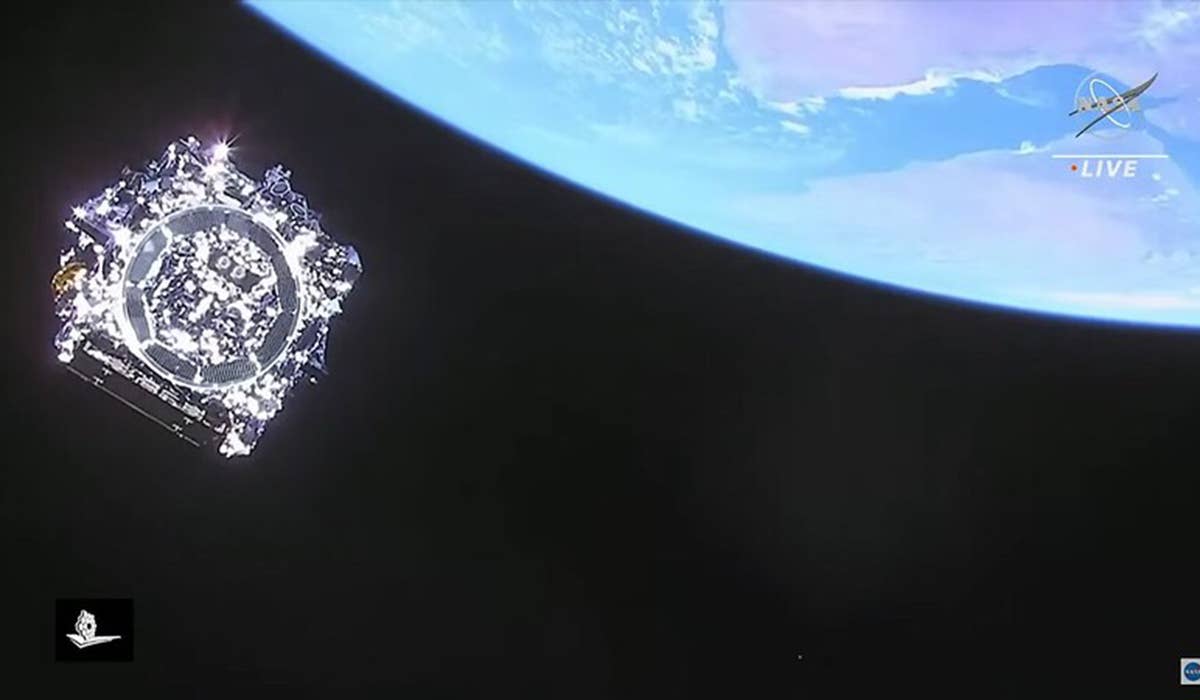What Amazing Things Will the World’s Largest Telescope Show Us?
James Webb aims to peer deeper into space than we’ve ever seen.

This image was captured by the cameras on board the rocket’s upper stage as the telescope separated from it. The Earth hovers in the upper right. [Photo: Arianespace, ESA, NASA, CSA, CNES]
The James Webb Space Telescope has successfully unfolded and is now on its way to an orbit 1 million miles away from Earth, but the mission has only just begun.
Webb, the world’s most powerful telescope, will peer into the depths of our universe and is expected to make once-in-a-lifetime discoveries. Here are some amazing things Webb could find across the universe.
Exoplanets
Since the 1990s, scientists from around the world have studied planets that exist outside of our solar system. The Hubble Space Telescope played a huge role in locating and identifying different types of planets much like our own.
With the power of Webb’s infrared instruments, we’ll be able to see many more exoplanets in even greater detail. From smaller terrestrial planets to Jupiter-sized ocean worlds and beyond, Webb will measure the presence of specific elements in their atmospheres to piece together what kinds of worlds have been littered among the stars.
According to NASA, the closest exoplanet to Earth is Proxima Centauri B, about four light years away. The exoplanet was discovered in 2016 and is theorized to have a mostly rocky surface. Scientists are yet to determine whether it has an atmosphere or not, but with Webb, we may soon find out.
The Beginnings of our Universe
Webb has often been referred to as a “time machine.” But what does that mean?
Ever since the Big Bang, scientists have determined that space is constantly expanding, which means, the distance between everything is growing. When light travels through our universe, its wavelength stretches and shifts down on the electromagnetic spectrum.
The phenomenon is known as “redshift” due to the light only being visible to infrared instruments. Luckily, Webb came prepared with gold-plated mirrors that are excellent at catching infrared light that would otherwise be invisible to ordinary telescopes.
When Webb points at the center of our universe, we will be able to see nearly 13.6 billion years into the past—catching light waves from right after the big bang.
Potential Life
Are we alone in the universe? While Webb may not find little green men in Alpha Centauri, the telescope is equipped to find the markers of extraterrestrial life.
One hundred and twenty-four lightyears away from Earth lies exoplanet K2-18b. Originally discovered by the Kepler Space Telescope, Hubble detected the presence of water vapor in its atmosphere. Now that Webb is mere months away from beginning observations, we could gain a more in-depth perspective of what K2-18b may be home to.
According to NASA, more than 4,000 exoplanets have already been found and Webb is sure to find more.
While the sea of stars and their planets are seemingly endless, there could be life right here in our own solar system. Webb will be utilized to gather incredible images of celestial bodies right next door.
Europa, one of Jupiter’s many moons, has been observed to be covered in a thick layer of ice, but scientists believe that water, liquified by heat from its core, could exist—and where there’s water, there is also a possibility for life.
What’s next for Webb?
The telescope is well on its way to Lagrange point 2, or L2, where it will park itself in an orbit far away from Earth. In about a month’s time, Webb will reach L2 and begin cooling down its instruments.
Once Webb reaches its operable temperature, negative 370 degrees fahrenheit, it will then calibrate its instruments by taking images of nearby stars. Afterwards, observations requested by scientists across the globe will take place and will continue for years to come.

Sign-up for newsletters & special offers!
Get the latest FLYING stories & special offers delivered directly to your inbox






